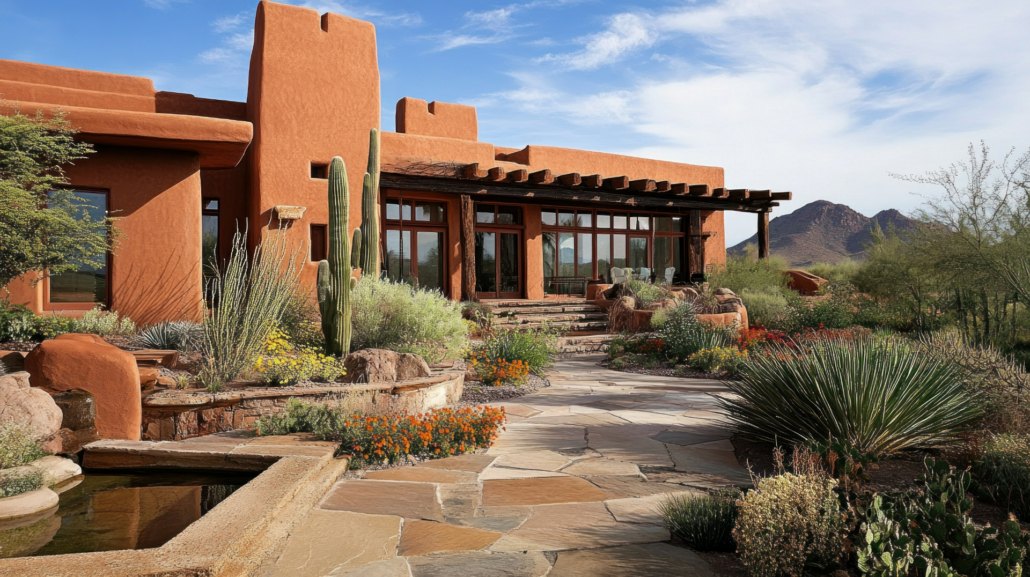Does Landscaping Increase Home Value? Understanding Its Effects


Homeowners typically examine different home improvement projects before listing their property to increase its market value. Investments in landscaping represent a strong possibility for a significant return on investment.
But does landscaping increase home value, and if so, by how much? To get straight to the point, the answer to the question “Does landscaping increase value of home?” is a resounding yes – with strategic landscaping choices potentially boosting your home’s value by 15-20%.
Landscaping encompasses both softscaping (plants, trees, and gardens) and hardscaping (paths, patios, and structures). Together, these elements create the overall outdoor aesthetic and functionality of your property.
Research shows that a well-landscaped home can increase resale price by 5.5% to 12.7%, with some premium landscaping projects pushing that figure to 20%. Real estate professionals consistently cite landscaping as one of the top investments homeowners can make before listing their properties.
Before starting major landscape renovations, contact our artificial grass specialists to guarantee optimal return on investment for your particular property in its market area.
How much does landscaping increase home value depends on several factors, including project type, quality, and regional preferences. Financial experts recommend spending between 10-20% of your home’s value on outdoor improvements to maximize returns. The most lucrative financial return in real estate development comes from adding living space that needs maintenance only once in a while.
The investment returns from different landscaping projects vary:
The initial impact of properties in real estate remains extremely important. Well-considered front yard garden arrangements will boost curb appeal before any potential buyer enters the house. The combination of colorful plants with properly mulched garden beds and an orderly presentation creates a substantial impact on buying potential before entrance exposure.
For properties where traditional landscaping poses challenges, alternatives like artificial turf can provide attractive, low-maintenance solutions.
Homebuyers today want outdoor living spaces that expand their home’s usable area. Decks, patios, and designated entertainment zones can transform underutilized yard space into valuable living areas. The average cost for wood decks reaches $17,051 with a return on investment rate of 50.2%, while composite decks reach $23,430 with a rate of return of 39.8%.
A vibrant green lawn stands as a highly economical investment in landscaping projects. The basic task of maintaining a lawn requires a $140 investment for each service, yet reseeding your lawn runs between $400 and $1,600 to achieve the mentioned 217% return on investment. The utilization of artificial grass products in particular areas works as a substitute for natural grass because it provides visual appeal with decreased water consumption.
Xeriscaping (drought-resistant landscaping) costs between $16,000-$18,000 upfront but can increase home value by 10-12% while saving significantly on water and upkeep. Potential home buyers increasingly appreciate environmentally conscious landscaping choices, particularly in drought-prone regions.
Strategic hardscaping elements like stone walkways, retaining walls, and firepits enhance both functionality and visual appeal. A firepit’s price range from $300 to $1,400 offers a 56% return on investment, which serves as an attractive central point for outside social events.
Outside lighting serves to improve both outdoor beauty along property protection measures. The installation costs between $3,500 and $4,500 generate, on average, a 59% ROI for outdoor lighting, which makes it a basic yet effective solution for enhancing nighttime courtyard appeal and extending usable space-time.
The right placement of trees together with shrubs functions as natural privacy barriers that attract prospective buyers. Mature trees located in residential properties boost market value by $1,000 to $10,000 while providing energy savings equivalent to 25% on heating and cooling expenses.
Sprinkler system installation costs between $1,600 and $10,000 result in an ROI of 83% while delivering superior homeowner satisfaction. These systems ensure consistent landscape health while conserving water through smart technology.
Year-round visual appeal in landscaping depends on selecting plants which display interest in each season. Modern landscaping approaches often layer different plant types to maintain visual appeal regardless of season.
Property value potentially decreases when homeowners develop too specialized garden designs which do not align with the local resident market. Property values increase more when buyers find the landscaping design attractive to a wide range of potential homeowners.
Swimming pools together with ponds and water features typically work against buyers because they raise concerns about maintenance work and security issues. Also, check that artificial grass for landscaping suits your climate zone and neighborhood regulations before installation.
The landscape that mismatches the regional climate creates a visual discord that indicates possible upkeep problems for potential buyers. The best landscaping approach involves using natural conditions instead of fighting against them to achieve optimal appeal.
Now that you know how much does landscaping increase home value, a well-executed landscaping plan is important. The key is balancing immediate visual impact with long-term functionality and maintenance considerations. Homeowners should choose established return-oriented projects and projects with broad market appeal in order to boost property value and quality of life.
Does landscaping increase value of homes consistently? Yes, when you make thoughtful choices aligned with buyer preferences and regional norms. By focusing on high-ROI projects and avoiding common pitfalls, your landscape improvements can significantly enhance both your enjoyment of the property and its eventual resale value.

Festival Turf
Phone: 844-702-8873
Email: [email protected]
Las Vegas HQ Hours
Monday-Friday: 8:00am – 4:00pm PST
Saturday: 8:00am – 12:00pm
Sunday: CLOSED
Have a Question?
Contact us now and we’ll help you find what you need!

 Secret Garden Design Ideas: Transforming Your Backyard into a Private Retre...
Secret Garden Design Ideas: Transforming Your Backyard into a Private Retre...